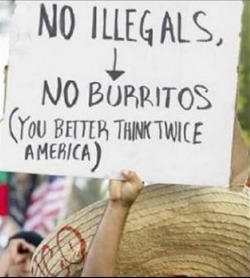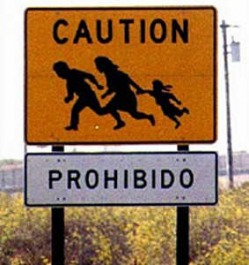Timeline
. 1941 The Fair Employment Practices Act is passed, eliminating discrimination in employment. Hispanics throughout the United States enthusiastically respond to the war effort as the country enters World War II.
1943 Prompted by the labor shortage of World War II, the U.S. government makes an agreement with the Mexican government to supply temporary workers, known as braceros, for American agricultural work. The so-called "Zoot Suit" riots take place in southern California. Some elements of the California press had been portraying Mexican Americans as unwelcome foreigners. Bands of hundreds of sailors, marines, and soldiers in southern California range the Hispanic neighborhoods, looking for Mexican American young men in zoot suits. When they find them, the soldiers beat them and tear their suits off of them.
1944 Fulgencio Batista retires as president of Cuba. Operation Bootstrap, a program initiated by the Puerto Rican government to meet U.S. labor demands of World War II and encourage industrialization on the island, stimulates a major wave of migration of workers to the United States.
1947 More than 20 airlines provide service between San Juan, Puerto Rico, and Miami, and San Juan and New York. The American G.I. Forum, a new civil rights organization, is founded by Mexican American veterans in response to a Three Rivers, Texas, funeral home's denial to bury a Mexican American soldier killed in the Pacific during World War II.
1950s Throughout the early 1960s, segregation is abolished in Texas, Arizona, and other regions, largely through the efforts of the League of United Latin American Citizens (LULAC) and the Alianza Hispano Americana. Immigration from Mexico doubles from 5.9 percent to 11.9 percent, and in the 1960s rises to 13.3 percent of the total number of immigrants to the United States.
1950s-1960s Black workers continue to be the most numerous migrants along the eastern seaboard states, while Mexican and Mexican-American workers soon dominate the migrant paths between Texas and the Great Lakes, the Rocky Mountain region, and the area from California to the Pacific Northwest. 1951 The Bracero Program is formalized as the Mexican Farm Labor Supply Program and the Mexican Labor Agreement, and will bring an annual average of 350,000 Mexican workers to the United States until its end in 1964.
1954 In the landmark case of Hernandez v. Texas, the nation's highest court acknowledges that Hispanic Americans are not being treated as "whites." The Supreme Court recognizes Hispanics as a separate class of people suffering profound discrimination, paving the way for Hispanic Americans to use legal means to attack all types of discrimination throughout the United States. It is also the first U.S. Supreme Court case to be argued and briefed by Mexican American attorneys.
1954-1958 Operation Wetback, a government effort to locate and deport undocumented workers, results in the deportation of 3.8 million persons of Mexican descent. Only a small fraction of that amount are allowed deportation hearings. Thousands of U.S. citizens of Mexican descent are also arrested and detained.
1955 In the early 1950s, Hispanic Americans had begun to buy time on local television stations for Spanish-language programs. New York, San Antonio, Corpus Christi, and Harlingen, Texas, have extensive Hispanic programming. The first Spanish-language television station in the United States is San Antonio's KCOR-TV in San Antonio.
1959 The Cuban Revolution succeeds in overthrowing the repressive regime of Batista; Fidel Castro takes power. Cuban Americans immigration to the United States increases sharply after this date. Large-scale Cuban immigration to the United States occurs much more quickly than that from either Puerto Rico or Mexico, with more than one million Cubans entering the country since 1959. Most of the two million Puerto Ricans who have trekked to the U.S. mainland in this century are World War II or postwar-era entries. Unlike the immigrant experience of Mexicans, or Cubans before 1959, the majority of Puerto Rican immigrants entered the United States with little or no red tape
1960s A third phase of labor migration to the United States begins when the established patterns of movement from Mexico and Puerto Rico to the United States are modified, and migration from other countries increases. The Bracero Program ends in 1964, and, after a brief decline in immigration, workers from Mexico increasingly arrive to work under the auspices of the H-2 Program of the Immigration and Nationality Act of 1952, as well as for family unification purposes, or as undocumented workers. Young Mexican Americans throughout the United States become caught up in the struggle for civil rights and seek to create a new identity for themselves. These efforts become known as the Chicano Movement. The movement sparks a renaissance in the arts among Mexican Americans. Many Chicano artists call attention to inequalities faced by Mexican Americans, developing new styles of art that eventually gain acceptance in mainstream literary and art scenes.
1961 Aspira (Aspire) is founded to promote the education of Hispanic youth by raising public and private sector funds. Aspira acquires a national following, serving Puerto Ricans wherever they live in large numbers. April. Anti-Communist Cuban exiles who are trained and armed by the United States, attempt a foray into Cuba that is doomed from the beginning. The failure of the infamous Bay of Pigs invasion embitters thousands of exiled Cubans, while strengthening Castro's position at home. Many observers throughout the world criticize President John F. Kennedy's administration for this attempt.
1962 The United Farm Workers Organizing Committee in California, begun as an independent organization, is led by César Chávez. In 1965 it organizes its successful Delano grape strike and first national boycott. It becomes part of the AFL-CIO in 1966. Today the union is known as the United Farmworkers of America. Congress enacts the first comprehensive civil rights law since the post-Civil War Reconstruction period when it passes the Civil Rights Act of 1964. One result of the act is the establishment of affirmative action programs. Title VII of the Act prohibits discrimination on the basis of gender, creed, race, or ethnic background, "to achieve equality of employment opportunities and remove barriers that have operated in the past." Discrimination is prohibited in advertising, recruitment, hiring, job classification, promotion, discharge, wages and salaries, and other terms and conditions of employment. Title VII also establishes the Equal Employment Opportunity Commission (EEOC) as a monitoring device to prevent job discrimination.
October. The United States blocks a Soviet plan to establish missile bases in Cuba. Soviet Premier Khrushchev agrees to withdraw the missiles with the proviso that the United States declare publicly that it will not invade Cuba.
1964 The Organization of American States (OAS) meets in Washington, D.C., voting to cut diplomatic and commercial relations with Cuba and to impose restrictions on travel there. The Economic Opportunity Act (EOA) is the centerpiece of President Lyndon B. Johnson's War on Poverty. The EOA also creates the Office of Economic Opportunity (OEO) to administer a number of programs on behalf of the nation's poor. These include the Job Corps, the Community Action Program (CAP), and the Volunteers in Service to America (VISTA).
1965 The end of the bracero program forces many Mexicans to return to Mexico. They settle near the U.S. border. To provide jobs for them, the Mexican and U.S. governments begin border industrialization programs, allowing foreign corporations to build and operate assembly plants on the border. These plants, known as maquiladoras, multiply rapidly, transforming the border region. The maquiladors attract companies because they provide cheap labor close to American markets. They employ hundreds of thousands of Mexicans in assembly work, but often in poor working conditions.
The Voting Rights Act of 1965 is passed, aimed at African American enfranchisement in the South. Obstacles to registration and voting are faced by all minorities, but the act's potential as a tool for Hispanic Americans is not fully realized for nearly a decade.
For the first time, the United States enacts a law placing a cap on immigration from the Western Hemisphere, becoming effective in 1968.
A major revision of immigration law results when Congress amends the Immigration and Nationality Act of 1952. The national origin quota system is abolished.
1966 Hundreds of Chicago Puerto Rican youths go on a rampage, breaking windows and burning down many of the businesses in their neighborhoods. Ostensibly, the riots are in response to an incident of police brutality, but the underlying causes are broader, linked to the urban blight that characterizes their life in Chicago. A program is initiated to airlift Cubans to the United States. More than 250,000 Cubans are airlifted to the United States before the program is halted by Castro in 1973. About 10 percent of the island's population immigrates to the United States between 1966 and 1973.
1968 Chicano student organizations spring up throughout the nation, as do barrio groups such as the Brown Berets. Thousands of young Chicanos pledge their loyalty and time to such groups as the United Farmworkers Organizing Committee, which, under César Chávez, has been a great inspiration for Chicanos throughout the nation. An offshoot of both the farm worker and the student movements, is La Raza Unida party in Texas, an organization formed in 1968 to obtain control of community governments where Chicanos are the majority.
1969 After the establishment of the Central American Common Market in the 1960s leads to economic growth and improved conditions in the region, the border war between Honduras and El Salvador brings its collapse and a rapid decline of economic conditions in Central America.
1970 Immigration and Naturalization Service (INS) Commissioner Leonard Chapman claims that there are as many as 12 million undocumented workers in the country. Other observers most commonly place the number in the range of 3.5 million to 5 million people. At this time 82 percent of the Hispanic population of the nation lives in nine states, with the proportion rising to 86 percent in 1990. The largest Hispanic populations are in California, Texas, and New York, and to a lesser degree Florida, Illinois, and New Jersey.
A Chicano Moratorium is announced in a protest against the Vietnam War organized in Los Angeles. More than 20,000 Chicanos and supporters draw attention to the disproportionately high number of Chicano casualties in that war. Conflicts erupt between police and demonstrators. Journalist Rubén Salazar, not involved in the struggle, is accidentally killed by police.
The struggle over affirmative action continues when opponents coin the term "reverse discrimination," suggesting that white males are victims of discrimination as a result of affirmative action on behalf of women, blacks, Hispanics, and other under-represented groups.
Brutality against Mexican Americans continues. In López v. Harlow, a case filed in an attempt to bring the violence under control, a police officer shoots and kills López, a Mexican American, allegedly in self-defense, because he thought López was about to throw a dish at him.
The amendments constituting the landmark Voting Rights Act of 1970 add a provision that is designed to guard against inventive new barriers to political participation. It requires federal approval of all changes in voting procedures in certain jurisdictions, primarily southern states. This act prevents minority votes from being diluted in gerrymandered districts or through at-large elections.
1970s-early 1980s The rise in politically motivated violence in Central America spurs a massive increase in undocumented immigration to the United States.
"Events in Hispanic American History, 1941 – 1970." Gale Schools- Celebrating Hispanic Heritage- Timeline- 1947. 1997. Gales Schools. 13 May 2009 <http://www.galeschools.com/hispanic_heritage/timeline/1941.htm>.
Stereotypes Against Mexican - Americans

The general stereotypes against the Mexican family are that the women are submissive and powerless women.This stereotype however is not true because most Mexican women have all the control and authority over family matters. Some general stereotypes are that all Mexicans are immigrants or are in the United States illegally. Also some stereotypes for Mexican are that they are lazy and the only jobs they can do is yard work. Mexicans are treated unfairly because Americans fear that they are going to take over their jobs.

